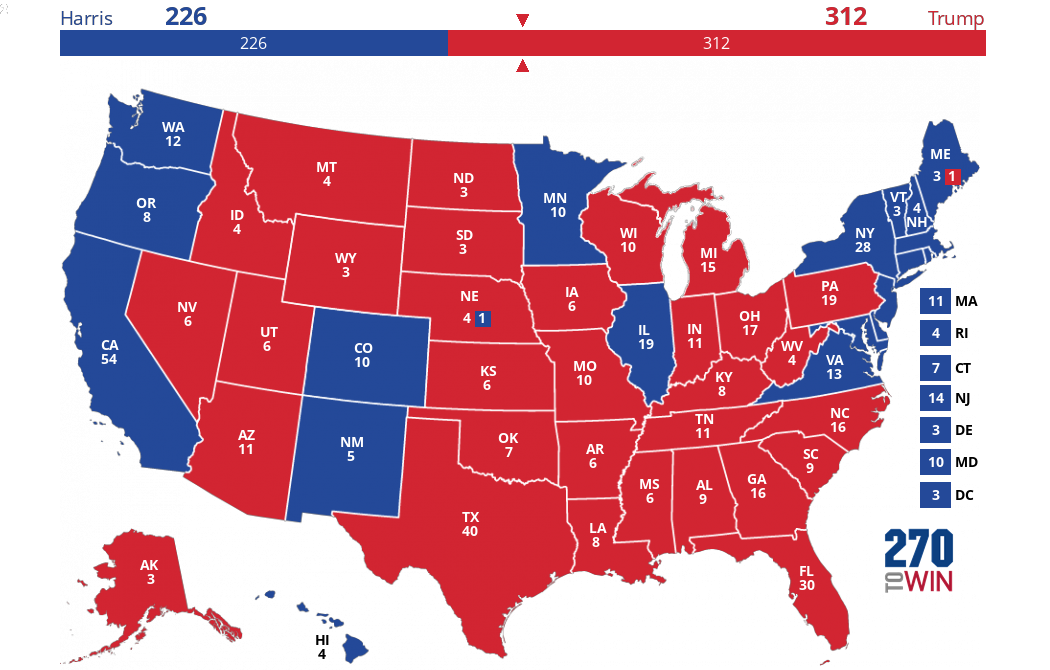Alabama
Alabama joined the Union in December 1819 and participated in all elections from 1820 on, except 1864 (due to its secession). Like most southern states, Alabama was a Democratic stronghold from Reconstruction through the 1950s. Southern Democrats were always more conservative than their increasingly liberal Northern brethren, which led to a period during which they put slates of unpledged electors on the ballot. This dissension in the party generally didn’t impact the final results. However, in 1960, six of the 11 Democratic winning electors were unpledged and all cast their votes for Harry F. Byrd.
Alabama largely abandoned the Democrats during the 1960s. The initial shift was primarily in response to white conservative voter uneasiness with the civil rights legislation that was passed in the mid-1960s, which was effectively exploited by the Republicans' "Southern Strategy." Republican nominees have won the state by over 20 points since 2004, including Donald Trump's nearly 31% margin in 2024. Alabama has had nine electoral votes since 1972 and will keep that number through at least 2028.
ELECTORAL VOTES
92024 ELECTION
Final Consensus Forecast
Recent Presidential Elections
| 2024 |
|
|||
| 2020 |
|
|||
| 2016 |
|
|||
| 2012 |
|
|||
| 2008 |
|
|||
| 2004 |
|
|||
| 2000 |
|
Presidential Voting History
State voted with the overall winning candidate
Electoral College Votes
Colored bars represent electoral votes by party. Tap or hover to see names.
Gray indicates available electoral votes that were either not cast or cast for a candidate not on the ballot.
An empty column indicates the state did not participate in that election.
U.S. Senate Voting History
| Class† | 1988 | 1990 | 1992 | 1994 | 1996 | 1998 | 2000 | 2002 | 2004 | 2006 | 2008 | 2010 | 2012 | 2014 | 2016 | 2018 | 2020 | 2022 | 2024 |
|---|---|---|---|---|---|---|---|---|---|---|---|---|---|---|---|---|---|---|---|
| 1 | |||||||||||||||||||
| 2 |
D
|
R
|
R
|
R
|
R
|
R
|
|||||||||||||
| 3 |
D
|
R
|
R
|
R
|
R
|
R
|
Data: MIT Election Data and Science Lab / Harvard Dataverse through 2018; 270toWin research. These are general election results for the years listed. Special elections, if any, are excluded.
† There are three classes of Senators; one is up for election every second year. Each state has one Senator in two of the three classes.
U.S. House Voting History
| District | 1988 | 1990 | 1992 | 1994 | 1996 | 1998 | 2000 | 2002 | 2004 | 2006 | 2008 | 2010 | 2012 | 2014 | 2016 | 2018 | 2020 | 2022 | 2024 |
|---|---|---|---|---|---|---|---|---|---|---|---|---|---|---|---|---|---|---|---|
| 1 |
R
|
R
|
R
|
R
|
R
|
R
|
R
|
R
|
R
|
R
|
R
|
R
|
R
|
R
|
R
|
R
|
R
|
R
|
R
|
| 2 |
R
|
R
|
R
|
R
|
R
|
R
|
R
|
R
|
R
|
R
|
D
|
R
|
R
|
R
|
R
|
R
|
R
|
R
|
D
|
| 3 |
D
|
D
|
D
|
D
|
R
|
R
|
R
|
R
|
R
|
R
|
R
|
R
|
R
|
R
|
R
|
R
|
R
|
R
|
R
|
| 4 |
D
|
D
|
D
|
D
|
R
|
R
|
R
|
R
|
R
|
R
|
R
|
R
|
R
|
R
|
R
|
R
|
R
|
R
|
R
|
| 5 |
D
|
D
|
D
|
D
|
D
|
D
|
D
|
D
|
D
|
D
|
D
|
R
|
R
|
R
|
R
|
R
|
R
|
R
|
R
|
| 6 |
D
|
D
|
R
|
R
|
R
|
R
|
R
|
R
|
R
|
R
|
R
|
R
|
R
|
R
|
R
|
R
|
R
|
R
|
R
|
| 7 |
D
|
D
|
D
|
D
|
D
|
D
|
D
|
D
|
D
|
D
|
D
|
D
|
D
|
D
|
D
|
D
|
D
|
D
|
D
|
Data: The Princeton Gerrymandering Project through 2018; 270toWin research. These are general election results for the years listed. Special elections, if any, are excluded.
Vertical lines before 1992, 2002, 2012, and 2022 show Census-related redistricting breakpoints. Geographic borders associated with each district number are likely to have changed.
The state had an additional redistricting before 2024.
Governor Voting History
Data: Wikipedia through 2018; 270toWin research. These are general election results for the years listed. Special elections, if any, are excluded.

